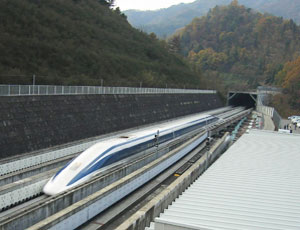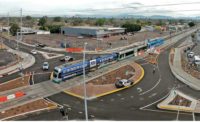

Many ENR readers have watched with interest the recent debate over the proposed Las Vegas-to-Los Angeles high-speed rail corridor running along Interstate 15. Long viewed as a potential maglev project, things got a little murky last month when U.S. Senate Majority Leader Harry Reid (D-NV) switched his support from maglev to conventional high-speed steel wheel technology. But what happened in Vegas is not staying there. With the advent of the Obama presidency, rail suddenly is a hot and potentially lucrative topic everywhere.
This year alone there already have been two rail Viewpoints, a Feb 25 piece entitled "Finally, Maglev Leadership" by Kevin C. Coates lauding the Obama sea-change in attitude and funding from the Bush years for Maglev and its importance to American technology and transportation, and an April 27 article "High-Speed Rail is a Game-changer" by Peter Gertler championing Obama's strategic rail vision and his $8-billion plan for a new high-speed rail system that could transform America. And there have been numerous ENR news stories on high-speed rail funding.
We all acknowledge how the interstate road system transformed America creating technology, transportation and building booms that forever altered our lifestyle and landscape. Is it now, in the depths of a Wall Street-fueled recession, time for another transformation? If we can continually bail out failing airlines and fund airport development, why not invest in a first rate railroad infrastructure that would compliment and enhance our Federal highway system? Many issues remain unresolved such as how fast is fast and should the line be publicly or privately owned? Should we go with 'proven' technology or make a quantum leap? And just why is there a high-speed rail gap between the U.S. and the rest of the developed world?
ENR.com kicks the discussion into high gear with two opposing Viewpoints, one supporting Maglev development by John Harding, a member of the International Maglev Board, and the other by Andy Kunz, president, US High Speed Rail Association in favor of 'conventional' high-speed rail. Readers are encouraged to read both articles then add their own voices to this debate. Steel wheels or maglev - you decide.
Maglev- It's All About Speed

HARDING
The case for maglev is very simple. If there is a need for a ground transportation mode, which on a practical basis can accelerate and travel appreciably faster than high-speed rail (HSR), then maglev is the only option on the horizon.
At the present stage of development, other comparisons- energy efficiency, capital cost, maintenance- will not be particularly relevant. This does not mean that there is no niche for maglev. In dense corridors of 200 to 1000 km in length, maglev can compete with air travel to play a big role in reducing congestion at major airports, while serving intermediate cities neglected by short haul air. In the U.S. several candidates appear viable: Washington-New York City-Boston, Santa Barbara-Los Angeles-San Diego, Los Angeles-Las Vegas, and possibly San Diego-Los Angeles-Santa Barbara- San Francisco-Sacramento. Each of these corridors has heavy commuter air service, which imposes big delays at the central airports.
The most clear-cut example of a niche for maglev is in Japan where, in fact, a credible commitment has been made to construct a 500 km/h, 290 km “Tokaido Maglev Bypass” connecting Tokyo and Nagoya. Central Japan Railway (CJR) the operator of the 270 km/h Tokaido Shinkansen between Tokyo, Nagoya and Osaka has provided the following arguments for this decision:
- The highly profitable Tokaido Shinkansen has reached its practical capacity limit, despite double-decked trains and 12 departures during peak hour, for a total of 309 trains and 413,000 passengers per day.
- Higher speeds are needed to maintain market share vis-à-vis the airlines. Trip time between Tokyo and Osaka has been reduced to 2h25m, for an average speed of 213 km/h with four intermediate stops. Configuration of the route does not allow higher speeds.
- The Tokaido Shinkansen infrastructure is 45 years old and is in urgent need of rehabilitation as a result of the high speed passage of over 3 billion tonne-km/km. Furthermore the line is threatened by a major earthquake, long overdue, which has the prospect of closing the line for months. This line is the lifeblood of the nation and its closure would have dire economic consequences, especially for CJR. A backup is sorely needed. The “Tokaido Maglev Bypass” will avoid the seismic danger zone south of Mt. Fuji.
- Maintenance of the Tokaido Shinkansen has become problematic, not simply because of cost, but because it is cutting into operating time. Experience has shown that higher speeds cause an unacceptable level of maintenance, as well as noise and vibration. Thus maglev with non-contact support and propulsion offers a way out.
Consequently CJR and the Railway Technical Research Institute have been developing superconducting maglev since 1962, with several billion dollars expended to bring a system to its present stage. In December 2003, a world record speed of 581 km/h was achieved on a test track in Yamanashi prefecture with the MLX01 three car train. Cumulative travel distance has reached 600 Mm (equivalent to15 circuits of the equator), with most of this at or near planned operating speed of 500 km/h. This differs from the public relation stunts wherein TGV on two occasions has reached speeds over 500 km/h, using modified equipment under ideal conditions, with consequent damage to tracks and catenary.
CJR concludes that the practicality of a revenue maglev line has been proved, although work is continuing to bring costs in line with high-speed rail. The Board of Directors announced in December 2007 that the economics are also proved and expects to expend 5.1 trillion yen on the project. This is $55 billion, which probably exceeds any U.S. project ever attempted, including the Panama Canal. Construction of the Bypass is scheduled to commence in 2015, when CJR’s five trillion yen debt to the government for the Shinkansen facilities is paid off. Completion and commencement of revenue service is expected in 2025. CJR claims that its anticipated profits from the Tokaido Shinkansen will be adequate to finance the project without government funding. Let’s hope that there is no Tokaido region earthquake before the line is finished.
After several decades and some billions of dollars, the German government and various corporate partners have perfected a maglev, the Transrapid that uses conventional electromagnets. For the past five years, a Transrapid has been in revenue service at the Shanghai Pudong airport and demonstrates excellent reliability and to-the-second availability. So far, the system has covered its operations and maintenance costs, but it is unrealistic to expect a 30-km long high-speed demonstration system to make money when it stops short of the city center at a less than convenient intermodal location. Since Shanghai, the Germans have spent over $120 million to reduce their construction costs and now say they are cost competitive with HSR.
From what has been demonstrated overseas these last several years, maglev is able to provide fast and reliable intercity transport. While the true cost for maglev is unknown (at least in U.S. market economy terms), we eagerly await a major deployment of the technology. Rather than being left behind in the world of hi-tech transportation, American industry and government needs to put aside their fear of failure and embrace this new technology.
High-Speed Rail is the Future of Transportation in America

KUNZ
Transportation delays currently cost America about $78 billion each year. The 21st century transportation solution is high-speed rail (HSR) - steel wheels on steel rails, which is fast, efficient, safe and has a very high capacity for moving large numbers of people and light freight quickly without delay. Since HSR is powered by electricity, it can operate past the age of oil, and is therefore not subject to the volatility of oil prices the way all of our current modes of transportation are. HSR can be powered by clean, safe renewable sources of energy including a combination of wind, solar, geothermal, and ocean/tidal power, depending on the region of the country. This freedom from oil enables HSR to end our serious oil dependency, which translates into energy security and national security.
America currently spends about $700 billion each year purchasing foreign oil. This is a huge, unsustainable drain on our economy and transfers a large part of our wealth to other nations. But as we build more miles of our national HSR system, this large trade deficit will be reduced each year by an ever-increasing amount to the point where the savings will be larger than the cost of constructing the national HSR system – meaning the system will end up costing nothing to America.
In addition to an economic and energy solution, our national HSR system will also be the most comprehensive and permanent solution to the climate crisis by reducing our carbon output by epic proportions. A national HSR system will also enable fast, efficient and safe mobility that will get America moving and make us more competitive as a nation. Every other industrialized nation has in place advanced HSR systems, or are rapidly building them now. China and Spain are each spending over $300 billion building thousands of miles of high-speed rail at lightening fast speeds. Numerous other countries are also building HSR to prepare for an oil-scarce future. We must do the same to remain competitive as a leading industrial nation, and to put into place a viable transportation system for a prosperous future.
Another great feature of a HSR system is the high level of safety these systems offer. In the 45 years of operation of the Japanese high-speed rail system, there has never been a single fatality, and their system has carried over 7 billion passengers during that time. This is even more amazing when you consider that Japan has frequent earthquakes and typhoons to deal with! France has a similar safety record. Their high speed trains carry over 900 million passengers each year and have never had a single fatality in the 25 year history of their system. This is a stark comparison to our auto-based system in which about 43,000 people are killed every year, and millions more injured.
A national HSR network forms the backbone of a sustainable America together with feeder rail systems such as regional and commuter rail, metros, light rail, electric buses, and bicycles. These enable walkable communities to function, and together form the best model for sustainable development.
High-speed trains have continued to advance over the years in their technology. The French lead the world in setting new speed records, and then breaking their own records. Last year, a conventional high-speed train set a new world speed record of 357 mph! This new world speed record took place on the new Paris to Strasbourg high-speed line just prior to opening to revenue service.
In April, President Obama laid out the first phase of a national HSR system along with a down payment and the official application process. This inspired us to form the US High Speed Rail Association and to develop a plan for the full build out of a complete national system. Our plan calls for a 17,000-mile HSR network built in 4 phases for completion in 20 years. This national system will be the next great infrastructure project in America, and will be the largest engineering and construction project since the interstate highway system. The infrastructure needs of this project are huge and include the construction of thousands of miles of new high grade track, signaling, and electrification, as well as hundreds of bridges, many miles of tunnels, hundreds of new train stations and numerous support facilities.
Constructing this new system will create millions of jobs across America, and will revive our manufacturing sector by creating an entirely new industry producing the trains and related components. Our vision sets high standards for state-of-the-art dedicated track, advanced control systems, elegant multi-modal train stations, and top-of-the-line 220 mph trains. HSR is a proven technology with more than 45 years of operations and many billions of passengers carried around the world safely and efficiently. No other transportation mode can match the safety and capacity of HSR.
To view our 17,000-mile national high-speed rail map, click here.



Post a comment to this article
Report Abusive Comment